Electrical Engineering: Antennas, Multiplexing Methods, and Analysis
VerifiedAdded on 2020/03/01
|6
|965
|239
Homework Assignment
AI Summary
This electrical engineering assignment delves into the classification and characteristics of different antenna types, including directional (Yagi and horn antennas), semi-directional, and omni-directional (cellular antennas). The assignment outlines their strengths, weaknesses, and applications. It also explains multiplexing techniques, specifically code division multiple access (CDMA) and frequency division multiple access (FDMA), highlighting their operational principles and comparative advantages. The document provides a clear understanding of how these technologies are used in wireless communication systems, including their uses in modern applications. Furthermore, the assignment includes references to support the information presented.

Running head: ASSIGNMENT
Assignment 1
[Student Name Here]
[Institution’s Name Here]
[Professor’s Name Here]
[Date Here]
Assignment 1
[Student Name Here]
[Institution’s Name Here]
[Professor’s Name Here]
[Date Here]
Paraphrase This Document
Need a fresh take? Get an instant paraphrase of this document with our AI Paraphraser
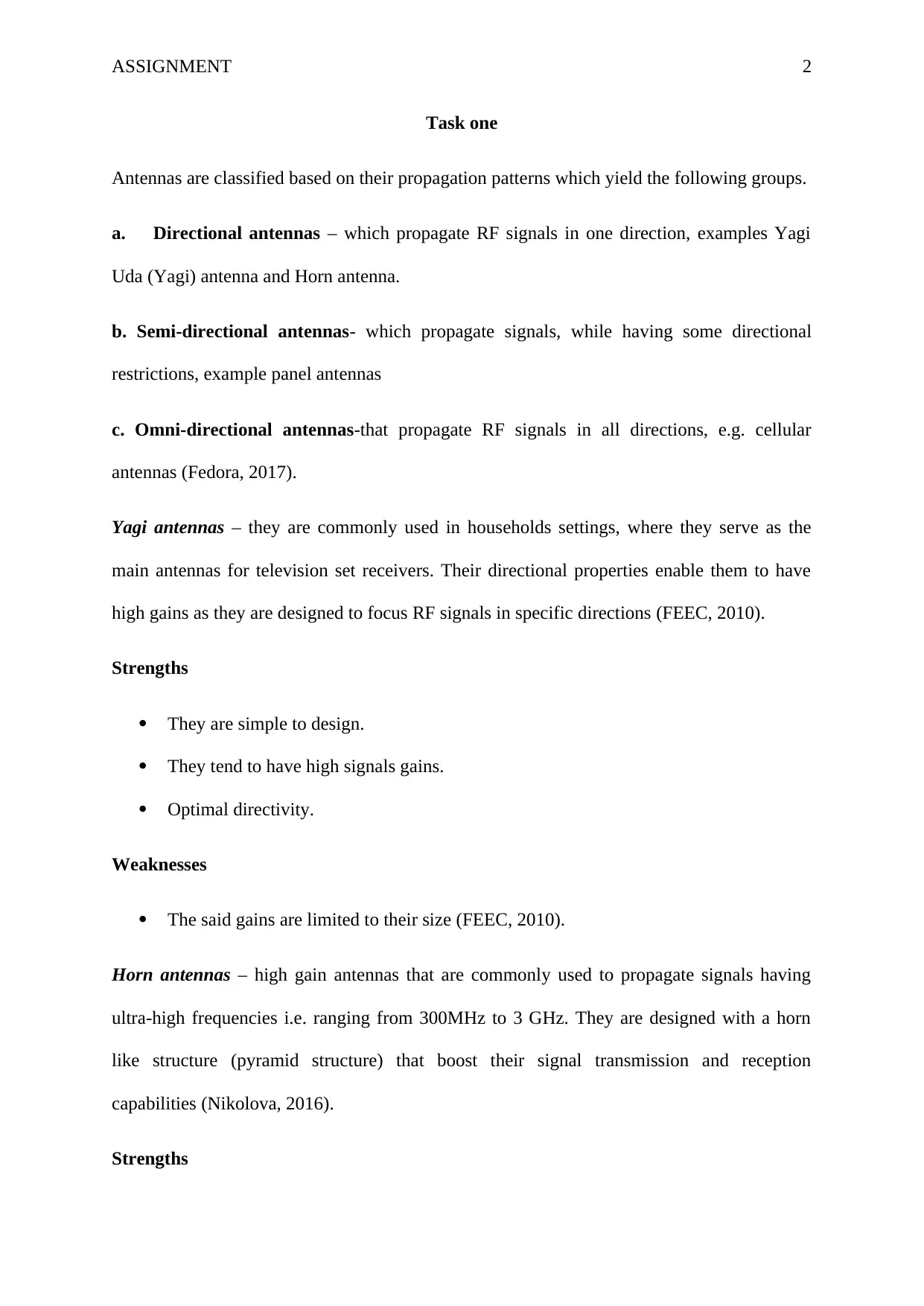
ASSIGNMENT 2
Task one
Antennas are classified based on their propagation patterns which yield the following groups.
a. Directional antennas – which propagate RF signals in one direction, examples Yagi
Uda (Yagi) antenna and Horn antenna.
b. Semi-directional antennas- which propagate signals, while having some directional
restrictions, example panel antennas
c. Omni-directional antennas-that propagate RF signals in all directions, e.g. cellular
antennas (Fedora, 2017).
Yagi antennas – they are commonly used in households settings, where they serve as the
main antennas for television set receivers. Their directional properties enable them to have
high gains as they are designed to focus RF signals in specific directions (FEEC, 2010).
Strengths
They are simple to design.
They tend to have high signals gains.
Optimal directivity.
Weaknesses
The said gains are limited to their size (FEEC, 2010).
Horn antennas – high gain antennas that are commonly used to propagate signals having
ultra-high frequencies i.e. ranging from 300MHz to 3 GHz. They are designed with a horn
like structure (pyramid structure) that boost their signal transmission and reception
capabilities (Nikolova, 2016).
Strengths
Task one
Antennas are classified based on their propagation patterns which yield the following groups.
a. Directional antennas – which propagate RF signals in one direction, examples Yagi
Uda (Yagi) antenna and Horn antenna.
b. Semi-directional antennas- which propagate signals, while having some directional
restrictions, example panel antennas
c. Omni-directional antennas-that propagate RF signals in all directions, e.g. cellular
antennas (Fedora, 2017).
Yagi antennas – they are commonly used in households settings, where they serve as the
main antennas for television set receivers. Their directional properties enable them to have
high gains as they are designed to focus RF signals in specific directions (FEEC, 2010).
Strengths
They are simple to design.
They tend to have high signals gains.
Optimal directivity.
Weaknesses
The said gains are limited to their size (FEEC, 2010).
Horn antennas – high gain antennas that are commonly used to propagate signals having
ultra-high frequencies i.e. ranging from 300MHz to 3 GHz. They are designed with a horn
like structure (pyramid structure) that boost their signal transmission and reception
capabilities (Nikolova, 2016).
Strengths
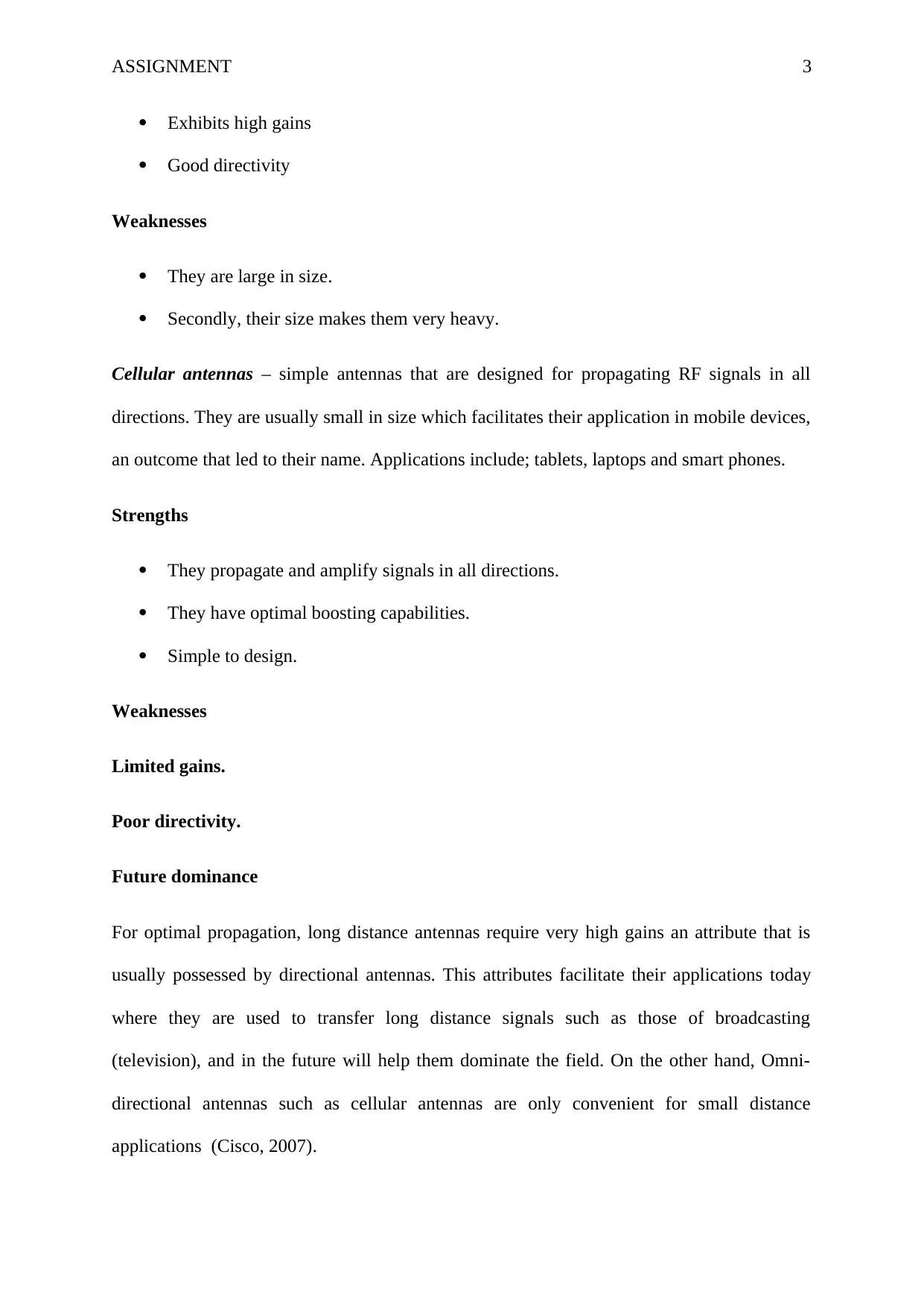
ASSIGNMENT 3
Exhibits high gains
Good directivity
Weaknesses
They are large in size.
Secondly, their size makes them very heavy.
Cellular antennas – simple antennas that are designed for propagating RF signals in all
directions. They are usually small in size which facilitates their application in mobile devices,
an outcome that led to their name. Applications include; tablets, laptops and smart phones.
Strengths
They propagate and amplify signals in all directions.
They have optimal boosting capabilities.
Simple to design.
Weaknesses
Limited gains.
Poor directivity.
Future dominance
For optimal propagation, long distance antennas require very high gains an attribute that is
usually possessed by directional antennas. This attributes facilitate their applications today
where they are used to transfer long distance signals such as those of broadcasting
(television), and in the future will help them dominate the field. On the other hand, Omni-
directional antennas such as cellular antennas are only convenient for small distance
applications (Cisco, 2007).
Exhibits high gains
Good directivity
Weaknesses
They are large in size.
Secondly, their size makes them very heavy.
Cellular antennas – simple antennas that are designed for propagating RF signals in all
directions. They are usually small in size which facilitates their application in mobile devices,
an outcome that led to their name. Applications include; tablets, laptops and smart phones.
Strengths
They propagate and amplify signals in all directions.
They have optimal boosting capabilities.
Simple to design.
Weaknesses
Limited gains.
Poor directivity.
Future dominance
For optimal propagation, long distance antennas require very high gains an attribute that is
usually possessed by directional antennas. This attributes facilitate their applications today
where they are used to transfer long distance signals such as those of broadcasting
(television), and in the future will help them dominate the field. On the other hand, Omni-
directional antennas such as cellular antennas are only convenient for small distance
applications (Cisco, 2007).
⊘ This is a preview!⊘
Do you want full access?
Subscribe today to unlock all pages.

Trusted by 1+ million students worldwide
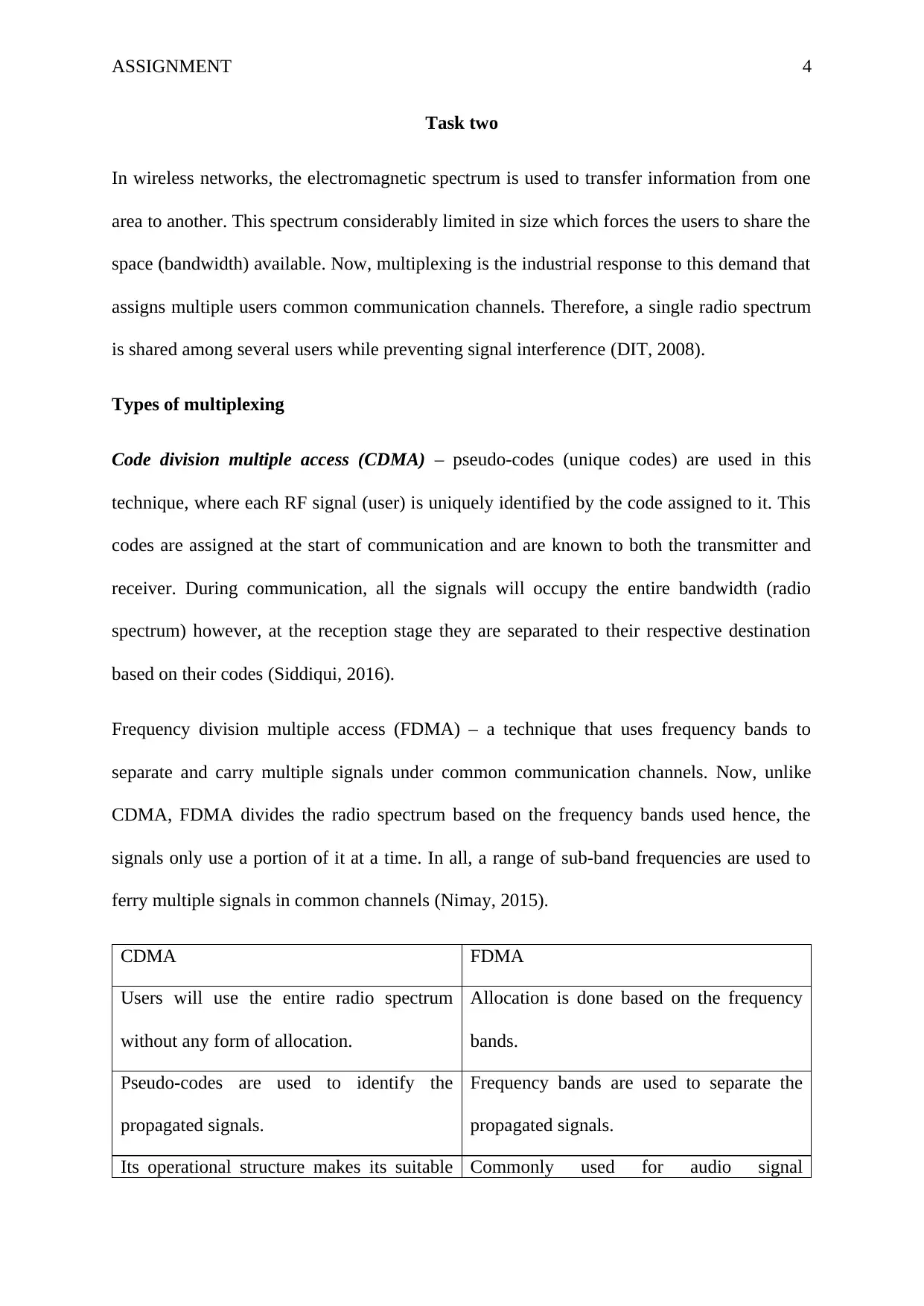
ASSIGNMENT 4
Task two
In wireless networks, the electromagnetic spectrum is used to transfer information from one
area to another. This spectrum considerably limited in size which forces the users to share the
space (bandwidth) available. Now, multiplexing is the industrial response to this demand that
assigns multiple users common communication channels. Therefore, a single radio spectrum
is shared among several users while preventing signal interference (DIT, 2008).
Types of multiplexing
Code division multiple access (CDMA) – pseudo-codes (unique codes) are used in this
technique, where each RF signal (user) is uniquely identified by the code assigned to it. This
codes are assigned at the start of communication and are known to both the transmitter and
receiver. During communication, all the signals will occupy the entire bandwidth (radio
spectrum) however, at the reception stage they are separated to their respective destination
based on their codes (Siddiqui, 2016).
Frequency division multiple access (FDMA) – a technique that uses frequency bands to
separate and carry multiple signals under common communication channels. Now, unlike
CDMA, FDMA divides the radio spectrum based on the frequency bands used hence, the
signals only use a portion of it at a time. In all, a range of sub-band frequencies are used to
ferry multiple signals in common channels (Nimay, 2015).
CDMA FDMA
Users will use the entire radio spectrum
without any form of allocation.
Allocation is done based on the frequency
bands.
Pseudo-codes are used to identify the
propagated signals.
Frequency bands are used to separate the
propagated signals.
Its operational structure makes its suitable Commonly used for audio signal
Task two
In wireless networks, the electromagnetic spectrum is used to transfer information from one
area to another. This spectrum considerably limited in size which forces the users to share the
space (bandwidth) available. Now, multiplexing is the industrial response to this demand that
assigns multiple users common communication channels. Therefore, a single radio spectrum
is shared among several users while preventing signal interference (DIT, 2008).
Types of multiplexing
Code division multiple access (CDMA) – pseudo-codes (unique codes) are used in this
technique, where each RF signal (user) is uniquely identified by the code assigned to it. This
codes are assigned at the start of communication and are known to both the transmitter and
receiver. During communication, all the signals will occupy the entire bandwidth (radio
spectrum) however, at the reception stage they are separated to their respective destination
based on their codes (Siddiqui, 2016).
Frequency division multiple access (FDMA) – a technique that uses frequency bands to
separate and carry multiple signals under common communication channels. Now, unlike
CDMA, FDMA divides the radio spectrum based on the frequency bands used hence, the
signals only use a portion of it at a time. In all, a range of sub-band frequencies are used to
ferry multiple signals in common channels (Nimay, 2015).
CDMA FDMA
Users will use the entire radio spectrum
without any form of allocation.
Allocation is done based on the frequency
bands.
Pseudo-codes are used to identify the
propagated signals.
Frequency bands are used to separate the
propagated signals.
Its operational structure makes its suitable Commonly used for audio signal
Paraphrase This Document
Need a fresh take? Get an instant paraphrase of this document with our AI Paraphraser
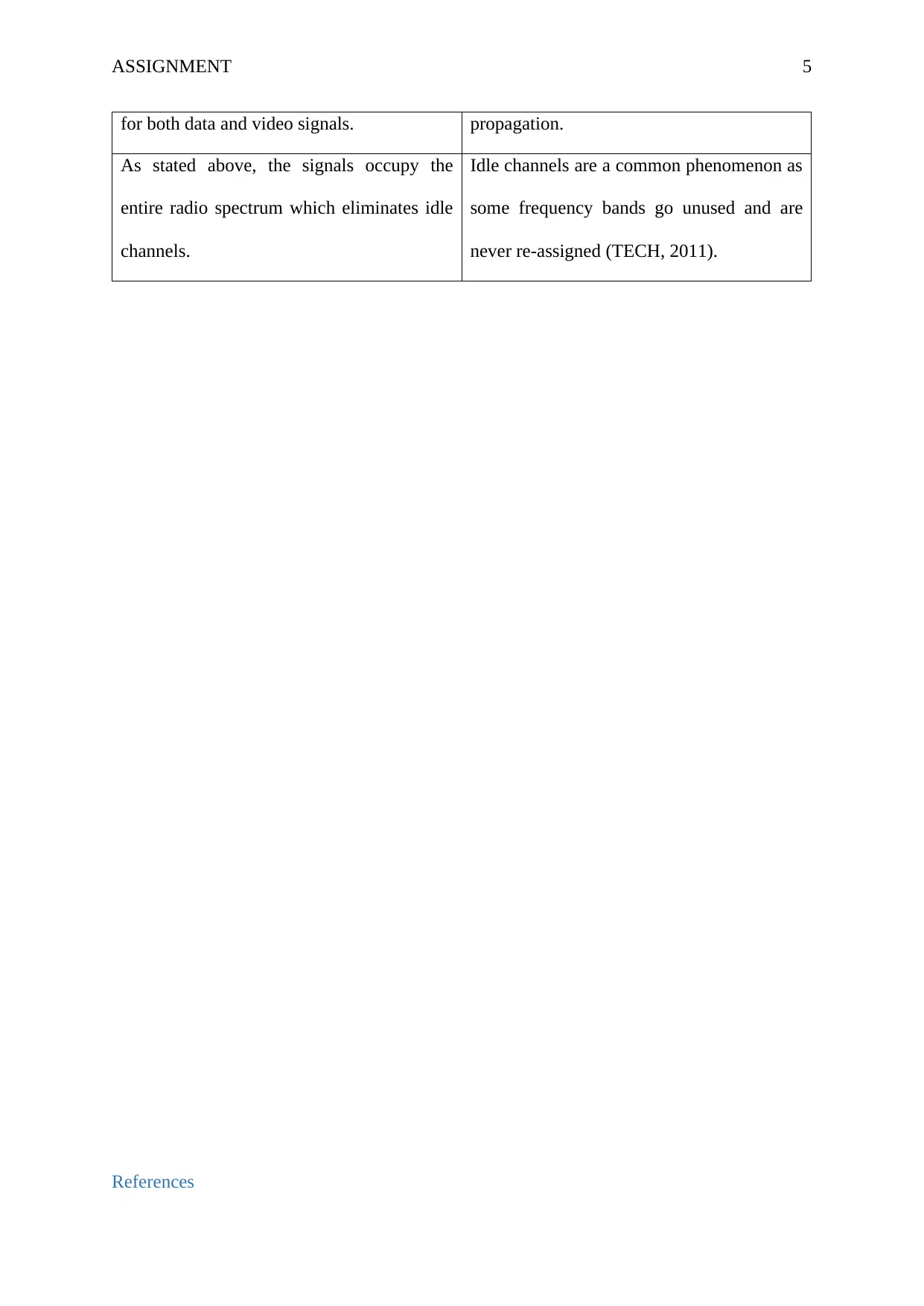
ASSIGNMENT 5
for both data and video signals. propagation.
As stated above, the signals occupy the
entire radio spectrum which eliminates idle
channels.
Idle channels are a common phenomenon as
some frequency bands go unused and are
never re-assigned (TECH, 2011).
References
for both data and video signals. propagation.
As stated above, the signals occupy the
entire radio spectrum which eliminates idle
channels.
Idle channels are a common phenomenon as
some frequency bands go unused and are
never re-assigned (TECH, 2011).
References
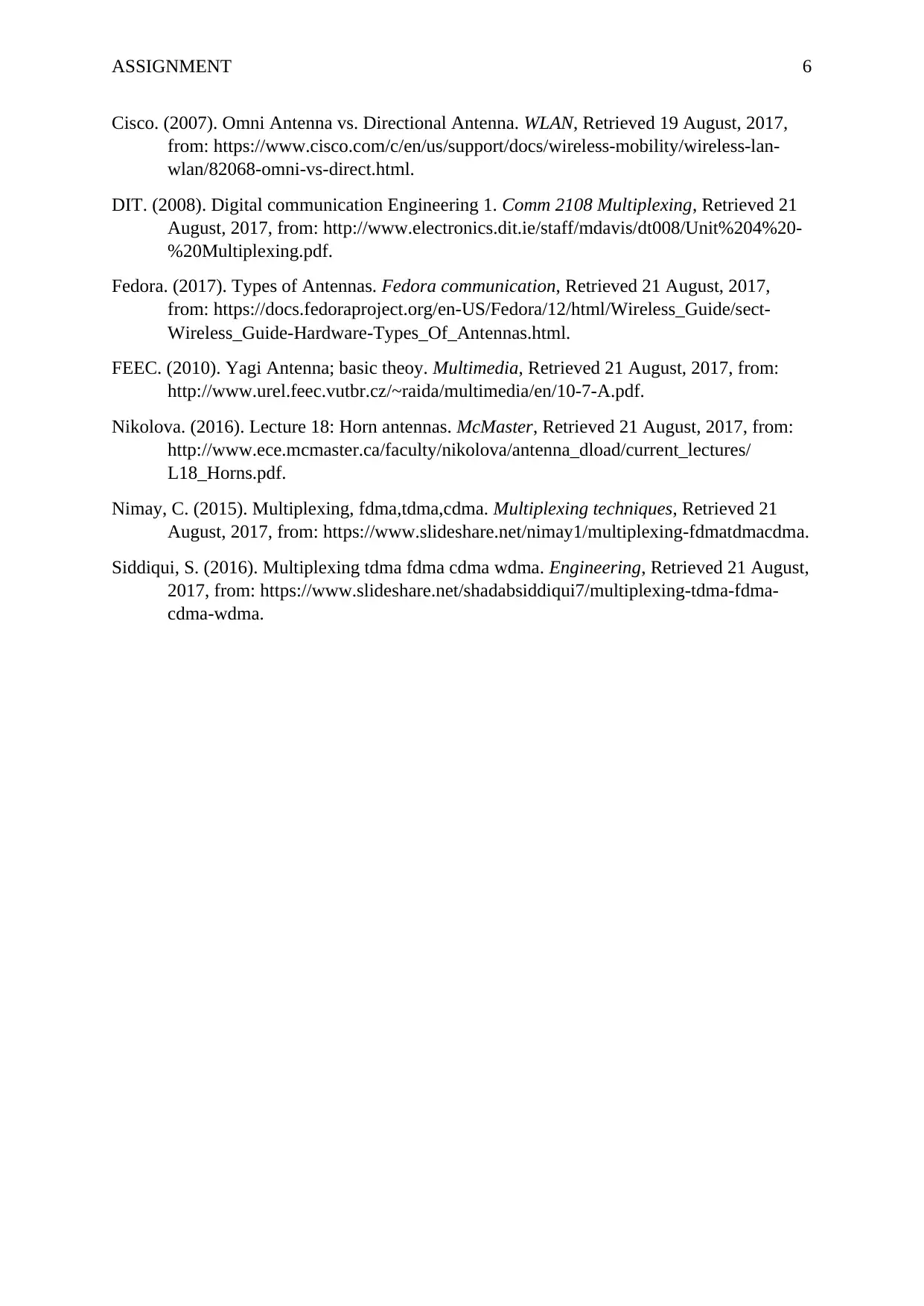
ASSIGNMENT 6
Cisco. (2007). Omni Antenna vs. Directional Antenna. WLAN, Retrieved 19 August, 2017,
from: https://www.cisco.com/c/en/us/support/docs/wireless-mobility/wireless-lan-
wlan/82068-omni-vs-direct.html.
DIT. (2008). Digital communication Engineering 1. Comm 2108 Multiplexing, Retrieved 21
August, 2017, from: http://www.electronics.dit.ie/staff/mdavis/dt008/Unit%204%20-
%20Multiplexing.pdf.
Fedora. (2017). Types of Antennas. Fedora communication, Retrieved 21 August, 2017,
from: https://docs.fedoraproject.org/en-US/Fedora/12/html/Wireless_Guide/sect-
Wireless_Guide-Hardware-Types_Of_Antennas.html.
FEEC. (2010). Yagi Antenna; basic theoy. Multimedia, Retrieved 21 August, 2017, from:
http://www.urel.feec.vutbr.cz/~raida/multimedia/en/10-7-A.pdf.
Nikolova. (2016). Lecture 18: Horn antennas. McMaster, Retrieved 21 August, 2017, from:
http://www.ece.mcmaster.ca/faculty/nikolova/antenna_dload/current_lectures/
L18_Horns.pdf.
Nimay, C. (2015). Multiplexing, fdma,tdma,cdma. Multiplexing techniques, Retrieved 21
August, 2017, from: https://www.slideshare.net/nimay1/multiplexing-fdmatdmacdma.
Siddiqui, S. (2016). Multiplexing tdma fdma cdma wdma. Engineering, Retrieved 21 August,
2017, from: https://www.slideshare.net/shadabsiddiqui7/multiplexing-tdma-fdma-
cdma-wdma.
Cisco. (2007). Omni Antenna vs. Directional Antenna. WLAN, Retrieved 19 August, 2017,
from: https://www.cisco.com/c/en/us/support/docs/wireless-mobility/wireless-lan-
wlan/82068-omni-vs-direct.html.
DIT. (2008). Digital communication Engineering 1. Comm 2108 Multiplexing, Retrieved 21
August, 2017, from: http://www.electronics.dit.ie/staff/mdavis/dt008/Unit%204%20-
%20Multiplexing.pdf.
Fedora. (2017). Types of Antennas. Fedora communication, Retrieved 21 August, 2017,
from: https://docs.fedoraproject.org/en-US/Fedora/12/html/Wireless_Guide/sect-
Wireless_Guide-Hardware-Types_Of_Antennas.html.
FEEC. (2010). Yagi Antenna; basic theoy. Multimedia, Retrieved 21 August, 2017, from:
http://www.urel.feec.vutbr.cz/~raida/multimedia/en/10-7-A.pdf.
Nikolova. (2016). Lecture 18: Horn antennas. McMaster, Retrieved 21 August, 2017, from:
http://www.ece.mcmaster.ca/faculty/nikolova/antenna_dload/current_lectures/
L18_Horns.pdf.
Nimay, C. (2015). Multiplexing, fdma,tdma,cdma. Multiplexing techniques, Retrieved 21
August, 2017, from: https://www.slideshare.net/nimay1/multiplexing-fdmatdmacdma.
Siddiqui, S. (2016). Multiplexing tdma fdma cdma wdma. Engineering, Retrieved 21 August,
2017, from: https://www.slideshare.net/shadabsiddiqui7/multiplexing-tdma-fdma-
cdma-wdma.
⊘ This is a preview!⊘
Do you want full access?
Subscribe today to unlock all pages.

Trusted by 1+ million students worldwide
1 out of 6
Related Documents
Your All-in-One AI-Powered Toolkit for Academic Success.
+13062052269
info@desklib.com
Available 24*7 on WhatsApp / Email
![[object Object]](/_next/static/media/star-bottom.7253800d.svg)
Unlock your academic potential
Copyright © 2020–2025 A2Z Services. All Rights Reserved. Developed and managed by ZUCOL.





